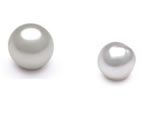JAPANESE AKOYA
Value Factors
The value of pearl jewelry can vary based on a few value factors. These factors include pearl luster, size, roundness, surface quality, color, and nacre thickness. For finished pearl jewelry pieces, matching is also very important.
Akoya Luster

The most important factor evaluating Akoya pearls is the luster. Luster or shine is how well a pearl
reflects. A good example is a mirror. An outstanding luster will have a mirror like shine and very sharp
image reflection. You can make out your own facial features. A smaller pearl with better luster will appear
larger. Also, a more lustrous pearl will appear rounder and blemishes will be less noticeable.
Pearl Grading Page
Akoya Body

Another pearl value factor is the cleanliness of the body or surface of the pearl. The more clean the
surface, the more valuable the pearl.
Pearls are a naturally formed organic gem so some minor surfaces blemishes are perfectly acceptable.
Pearl Grading Page
Akoya Size

The size of the pearl also does effect the value. A larger pearl with similar other value factors will be
more valuable than a smaller one. However, there is a size range where values increase exponentially. Akoya
pearls average between 6mm to 7mm. As a result, pearls at or under that size range are more readily
available. When the size range increases to 7mm to 8mm and subsequent 8mm to 9mm and greater than 9mm+
ranges, the value increases dramatically.
Pearl Grading
Page
Akoya Shape

Cultured Akoya are nucleated with round beads. These round beads are the foundation for a round pearl.
The rounder the pearl, the more valuable the pearl will be. Some symmetrical shapes such as drops also can
command high values as well.
Pearl Grading Page
Akoya Nacre

As cultured Akoya are bead nucleated, the nacre thickness and quality are both important. Colder water and
longer culturing times allow for thicker, tighter nacre formation resulting in more lustrous nacre.
Environmental conditions in Japan tend to allow for this type of nacre. Chinese waters allow for an
accelerated growth, but at a cost of lower quality nacre.
Pearl Grading Page
Akoya Matching
The pearls within an Akoya jewelry piece should be well matched in color and size. There should be no obvious
differences or anomalies. For a set the pearls should match within each piece as well as the set as a whole. For
example, earrings should match the necklace and bracelet.
Akoya Origin and Certification
Almost a century of experience in culturing and processing make the Japanese cultured Akoya the more valued
standard. In addition, the Japanese pearl industry is regulated by the JPEA. The Chinese Akoya pearl also has its
advantages. The accelerated growth and processing allows for a more affordable pearl. These two origins produce
Akoya options for the jewelry marketplace allowing consumers more choice.

 Look for this badge in our store. It means that the Item is Akoya Certified
Look for this badge in our store. It means that the Item is Akoya Certified
Processing Akoya
Careful processing of Akoya can take between two weeks to six months. Akoya are carefully processed to bring out
their natural beauty. The processing should not damage the pearl.
The Japanese have had nearly a century of processing experience which has resulted in many patented and secret
techniques.
The Chinese are relatively new to Akoya culturing, starting about the late 1980's. The culturing, processing and
environmental factors allow for faster growth and processing. Black and darker-colored Akoya processes also occur at
this time.

